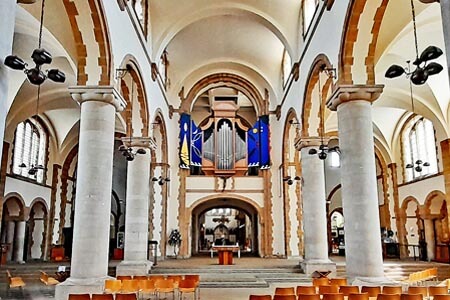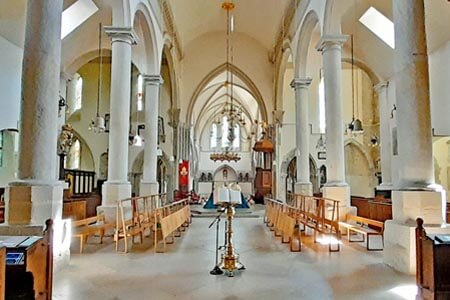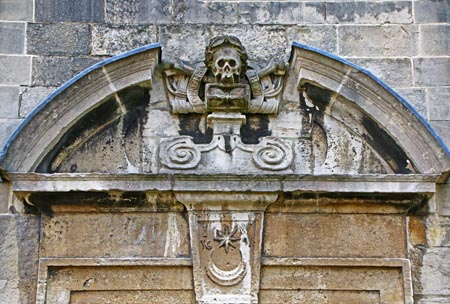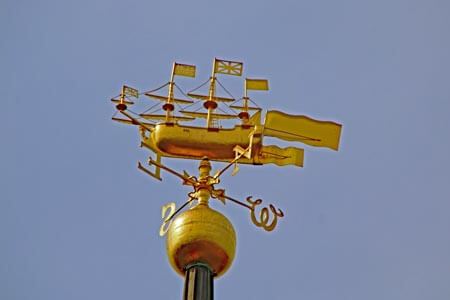St Thomas Cathedral Portsmouth
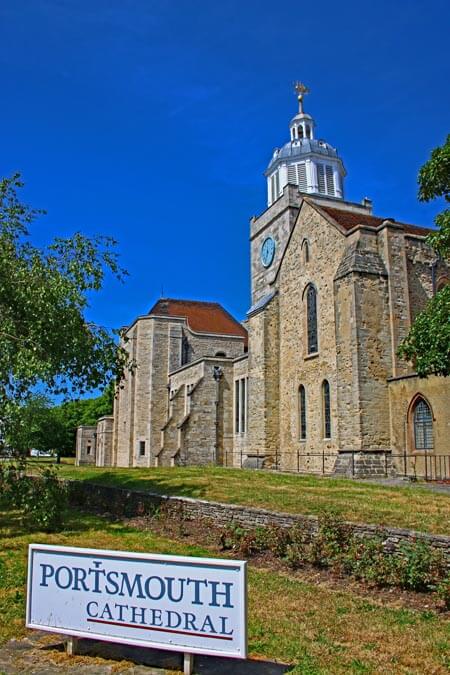
Located on the High Street in the historic Old Portsmouth area of Portsmouth is the Anglican Cathedral of St Thomas. The cathedral was constructed from 1185 on land gifted to Southwick Priory by Jean de Gisors the founder of Portsmouth.
Jean de Gisors was a French nobleman born in 1133, he owned Buckland Manor and helped develop the town of Portsmouth in order to develop trading links between England and France.
He donated an acre of land to the Augustinian order of Southwick Priory to enable the construction of a chapel, the chapel was dedicated to the martyr Thomas Becket, the Archbishop of Canterbury, murdered in 1170.
Construction of Portsmouth Cathedral began in 1185, the nave and chancel were completed in 1188 and by 1196 the altars, and trancepts were completed. Cruciform in design, the central tower was also used as a lighthouse and a look out point.
The church of St Thomas has been at the centre of Portsmouth's historic events over the years, being damaged on various occasions.
In 1337 the building was attacked by the French during the 100 Years War and was damaged by incendiary weapons.
The building was further damaged during the English Civil War (1642 - 1651). Gunners in Gosport successfully fired across Portsmouth Harbour damaging the bell tower.
At this time Royalist Portsmouth was under siege by Parliamentarian forces. This cannon fire resulted in the destruction of the original medieval tower and the nave.
In 1449 the church closed for a period, following the murder of Adam Moleyns, the Bishop of Chichester and Keeper of the Kings Privy Seal. He was killed close to the Domus Dei, during a dispute over wage payments to soldiers and sailors in the town. The entire town of Portsmouth was excommunicated, religious services could not be held in the town for almost fifty years and the development of Portsmouth during this period would have been badly effected.
In 1660 King Charles II authorised a collection in churches across the country to raise funds to rebuild the nave and tower, the £9,000 required was raised and the rebuilding work was carried out between 1683 and 1693.
The Cathedral bells were originally housed in the old Pharos (Roman lighthouse) which stands next to the church at Dover Castle. These were gifted to Sir George Rooke (MP for Portsmouth) in 1703 by Prince George of Denmark the Queens Consort, husband of Queen Anne. Sir George in turn donated the bells to St Thomas' and subsequently these bells were melted down and recast into five new bells for Portsmouth, a further three were added at a later date.
The inscriptions on the bells are as follows:
- Prosperity to all our benefactors.
- Peace and good neighbourhood, A.R 1703
- God save Queen Anne, A.R 1703
- I was cast by Joshua Kipling in the year 1737
- Abra Rudhill, of Gloucester cast us, 1703
- God save our Queen, Prince and Fleet, Annon Domini, 1703
- Thomas Mears, of London, 1794
- W.Bartlett, R.Phelps, Fecit 1730, Messieurs James Yeatman, and Nicholas Horwood, Churchwardens. We good people do call. We honour to King and brides joy do bring. Good tidings we tell, and ring the deads knell.
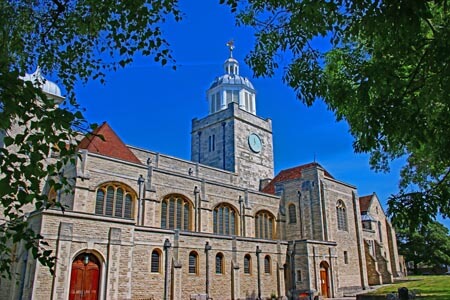
Above the cupola is a gilt model of a ship, the Golden Barque, in the form of a weather vane, this ship is 6ft 6ins long. The Golden Barque was installed on the cupola in 1710, an inscription on the forward flag reads M.C.E.S 1710. In 1954 it was blown down during a storm and is now on display inside the cathedral, mounted on oak timbers recovered from HMS Victory. The current Golden Barque, along with the entire bell tower, underwent a major restoration project in 2015.
Jonas Hanway born in Portsmouth in 1712 was buried at St Thomas Cathedral. Although a working as a social reformer, Hanway is most famous as the first man to carry an umbrella on the streets of London. His gravestone is in the south gangway of the Chancel.
In 1902 the foundations of the chancel were found to be in a dangerous condition and it was necessary to carry out extensive repairs, several walls were underpinned and two small galleries were removed, the cathedral was closed for two years during this renovation work.
In 1927 St Thomas church was chosen to become the Cathedral for the Diocese of Portsmouth and work began in 1930 to enlarge the building for this purpose. However due to the Second World War, work on the building was suspended in 1940 and was not completed until 1991.
The design of the extension to the church of St Thomas was submitted by Charles Nicholson and English architect who specialised in church and cathedral restorations. During the Blitz on Portsmouth the building was again damaged with windows and the roof being effected. Unfortunately Charles Nicholson died in 1949, Field Marshall Montgomery supported efforts to get the building works completed during the 1960's but little or no funds were available and again the extension works stalled. The building was still used in it's origin form during this period. £3 million were raised and work resumed in January 1990. The extension, although smaller than the original plans, added a fourth bay to the nave, the western towers, the rose window and a gallery. The completed Cathedral was finally consecrated in 1991 in the presence of Queen Elizabeth The Queen Mother.
Portsmouth Cathedral details:
Address: St. Thomas Street, Old Portsmouth, Hampshire, PO1 2HA
Telephone: 02392 823300
To the rear of the cathedral, above the north entrance, there is a skull carved into the stonework, picture below. This is a monento mori the Latin expression 'remember you must die' a symbolic reminder of the inevitability of death. This is used to emphasise the role of heaven and hell and that salvation can be achieved, not as a morbid practice but as an inspiration to live a good life. This stonework was originally above the main west door, but was moved in 1937 to make way for a new Nave.
St Thomas' Cathedral Portsmouth gallery
